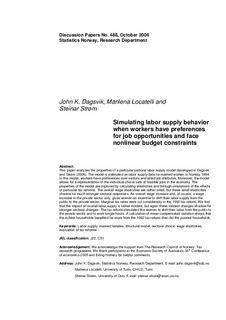| dc.description.abstract | Abstract:
This paper analyzes the properties of a particular sectoral labor supply model developed in Dagsvik
and Strøm (2006). The model is estimated on labor supply data for married women in Norway 1994.
In this model, workers have preferences over sectors and latent job attributes. Moreover, the model
allows for a representation of the individual choice sets of feasible jobs in the economy. The
properties of the model are explored by calculating elasticities and through simulations of the effects
of particular tax reforms. The overall wage elasticities are rather small, but these small elasticities
shadow for much stronger sectoral responses. An overall wage increase and, of course, a wage
increase in the private sector only, gives women an incentive to shift their labor supply from the
public to the private sector. Marginal tax rates were cut considerably in the 1992 tax reform. We find
that the impact on overall labor supply is rather modest, but again these modest changes shadow for
stronger sectoral changes. The tax reform stimulated the women to shift their labor from the public to
the private sector and to work longer hours. A calculation of mean compensated variation shows that
the richest households benefited far more from the 1992 tax reform than did the poorest households.
Keywords: Labor supply, married females, structural model, sectoral choice, wage elasticities,
evaluation of tax reforms | en_US |
